|
These junipers do very well in Cornwall as long as the soil used is free draining to cope with the wet months, and you feed them well. They are a very easy tree to keep alive too, and with correct pruning they will stay dense and healthy.
Over the last 15 years I've had some reasonable success with Junipers and gained the confidence with some smaller ones to try a couple of larger projects. The first was a tree from Anne swintons collection that was a lovely old imported tree that had run a bit wild for a good 10-12 years. The branches were plentiful but had remained unpruned so all the inner growth had dropped off leaving very long bare wood with foliage on the very ends. The trunk had a nice curve low down but after that was quite straight and thin for the overall size of the tree, and looking at the material it was hard to see the original design. Checking back it looked likely the tree was imported between 1969 and 1975 by Anne and the tree would now be somewhere between 75 and 100 years old.
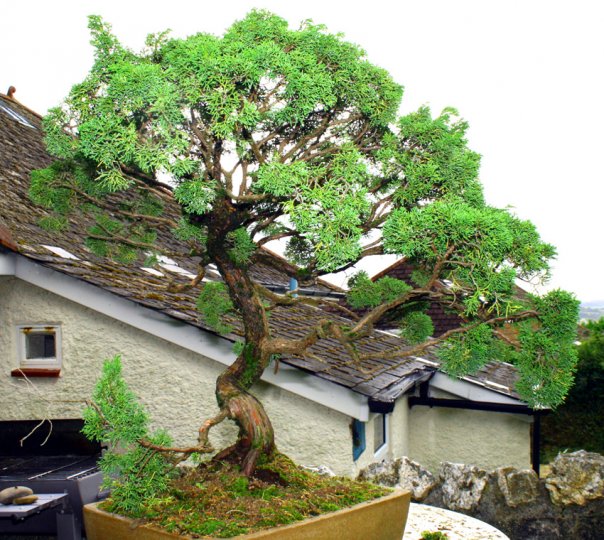
This is the tree in its original state. It had that huge head of thin branches and for a poorly looked after bonsai it retained a fairly good quality to the foliage. The first styling was a very gentle affair - most branches were kept so the tree wasnt weakened but i wired everything and gave the tree a basic outline, even though it was very large because of the long branches. This basic first styling was done to point the tree in a direction while i spent 18 months feeding it very well in readiness for a repot.
Here is the tree styled but with a long way to go:
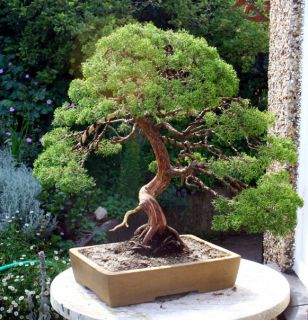
After the repot the tree started producing plenty of inner growth and gradually over the last 6 years I have managed to prune back some of the longer branches and even prune out weaker sections in favour of the new strong growth. This positive response comes from the soil used **.
Kiryu, akadama & sphagnum moss is the mix - 30:60:10.
This promotes root growth in an old tree, and with new roots you get new strong foliage. I water when the akadama looks dry (lighter colour) but spray over the foliage most days in summer.
** - these trees originate on limestone mountains so i'm looking to making a new limestone based soil mix **
3 years on and the foliage is a much better colour now and I gave the tree a major overhall in summer 2011. The entire crown was bent forward 90 degrees, the spidery branches on the right were removed and the lowest branch swapped from right to left.
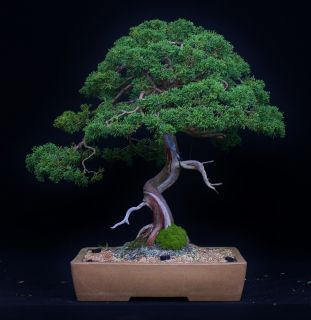 Now the tree is 12" shorter and about 16" narrower and slowly getting a better proportion. Having lived with the tree for a few months though it still has too much head for the thin trunk so there were two choices - a further reduction of the foliage or a drastic increase in the trunk.........so I decided to use the tree as a tanuki!! Now the tree is 12" shorter and about 16" narrower and slowly getting a better proportion. Having lived with the tree for a few months though it still has too much head for the thin trunk so there were two choices - a further reduction of the foliage or a drastic increase in the trunk.........so I decided to use the tree as a tanuki!!
We cut a log from a juniper in the japanese garden near Newquay about 2ft long and I roughly carved it to shape so the tree could be screwed to it. To fit it in the pot i moved the tree to a big mica rectangle and now have a few years refining the tanuki trunk and i need to grow some extra cuttings from the tree to run another lifeline up the new dead wood. The trunk is now about 10"across at the base and the foliage mass is perfectly in balance but needs re-wiring to suit the new design.
Maintaining Juniper foliage pads
On just about every branch you will get three types of foliage - 1) weak, thin growth, 2) nice tight pad forming growth and 3) vigorous extension growth.
1) These shoots will not change into the tight pad growth so will end up removed from the overall design. If the tree you are working on has a lot though it will weaken it too much to remove all these weak shoots in one go, especially as the desirable foliage often sprouts from the base of these weak shoots when the tree is well fed. Usually the weak shoots are growing on the inner parts of the branches where light and air circulation are poorest and the very weak ones will hang down, so cut these off. The others can be left in place if they dont effect the design as they are helping keep inner branch areas from going totally bare.
2) These are the perfect multi branched clusters of tight dense foliage that will form the finished branches. These shoots send out many tips in all directions and will get very dense over the years. Initially we keep all these shoots as they extend very slowly so the tree develops the pads we are aiming for. In time these shoots grow so densely that light cannot penetrate the inner tree so a percentage need cutting out with scissors - I remove every other shoot along the branch they are growing from.
NB. Many books say to pinch the tips of this foliage off with finger tips but I have recently been advised to never pinch the foliage by a very respected and experienced grower due to the weakening effect it has on the tree. I must admit in previous years I have pinched foliage pads and they always turn brown on the tips and never form more tight growth from the pinched areas - so it doesnt actually achieve any benefit to the design.
3) The vigorous shoots are much lighter in colour and will extend 4-10" in a growing season. The foliage is spread out along these shoots and they become branch or trunk extensions. In exactly the same way as the needle juniper you let them grow for several months so the tree gains strength and energy from the new green shoots. Then you cut them off with scissors back to the base (unless you are growing the branch longer). This checks the extension growth and promotes the strong short growth we are aiming for.
Styling
Junipers are very pliable and wire very well. (I will wire at any time of the year and always use copper). The larger branches swell quite quickly and the wire will need checking every year but the small wires on the finer branches can often stay for 3 years or even more as the fine twigs dont thicken much while you are developing the foliage.
A juniper will fit virtually every bonsai style except broom, but are a fantastic species for styling in dramatic curves showing aged dead wood and layered pads of foliage. They are a fast grower and the form is not spoilt if the tree is fed well with the needle colour showing a deep healthy green. Weak shimpaku, waterlogged or root problems all make the tree go yellow
Dead wood
In the wild the weathering will strip bark exposing the heartwood. This harder core naturally bleaches white and slowly erodes in beautiful curves and aged cracked patterns. The wood is scoured by winds driving sand, dirt and even ice particles so the weathering is normally localised to the exposed side, while thin live veins on the lee side carry the sap to the foliage. We may get a bonsai that already has this prized natural deadwood, or we can carve the tree and preserve it so it appears older and weathered. However you get the wood it needs constant protection from algae, insects and rotting. On the exposed sections lime sulphur is commonly used and this bleaches and protects for one year, needing re-applying annually.

The most overlooked area is below the soil though and this wet area needs much better protection. This tree is a japanese wild mountain specimen around 200 years old. The trunk has slowly rotted away leaving a beautiful hollow base. To protect the lower trunk I have eased away the soil, allowed it to dry and brushed it with various wire brushes to remove the loose flakes. Once clean I treat with a specialist wood treatment for weatherproofing and protecting wooden outdoor furniture.
 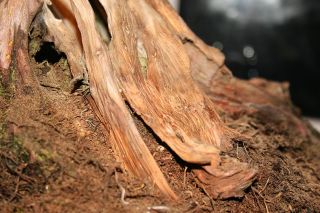
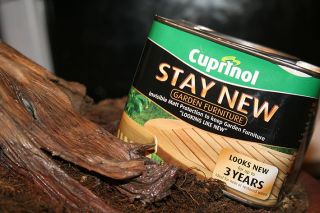
Once the lower trunk is protected the algae growing up the main trunk needs removing. To do this I use an electric toothbrush and water. This removes the old lime sulphur as well so once the trunk is dry again we will re-apply it - diluted 1:1 with water and with a soft brush so it doesnt splatter.
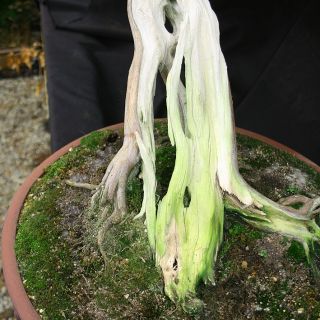 
As the tree is not planned for any shows all moss is removed as well as it traps too much water.
Tree overwintered, wired and styled

|